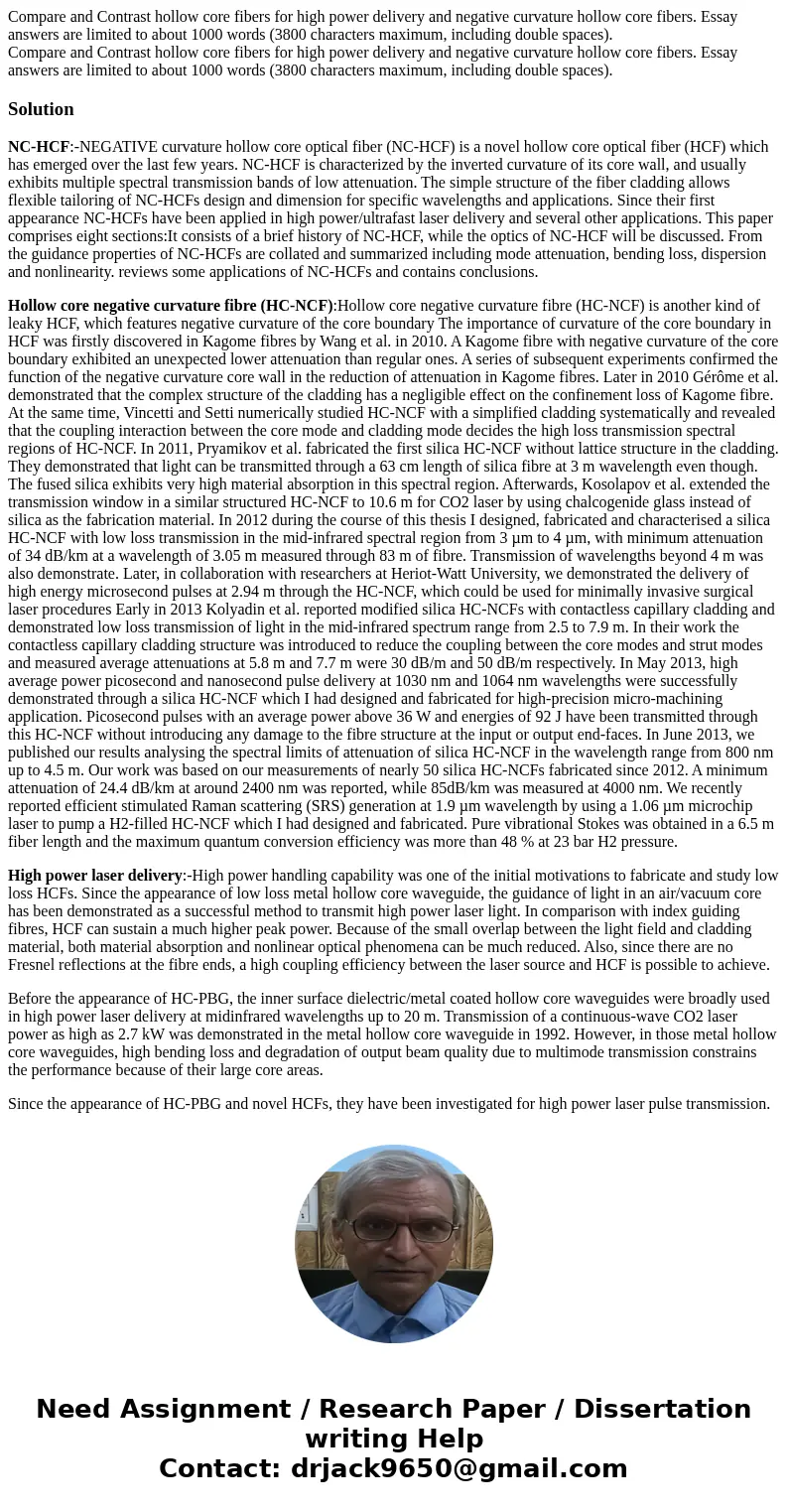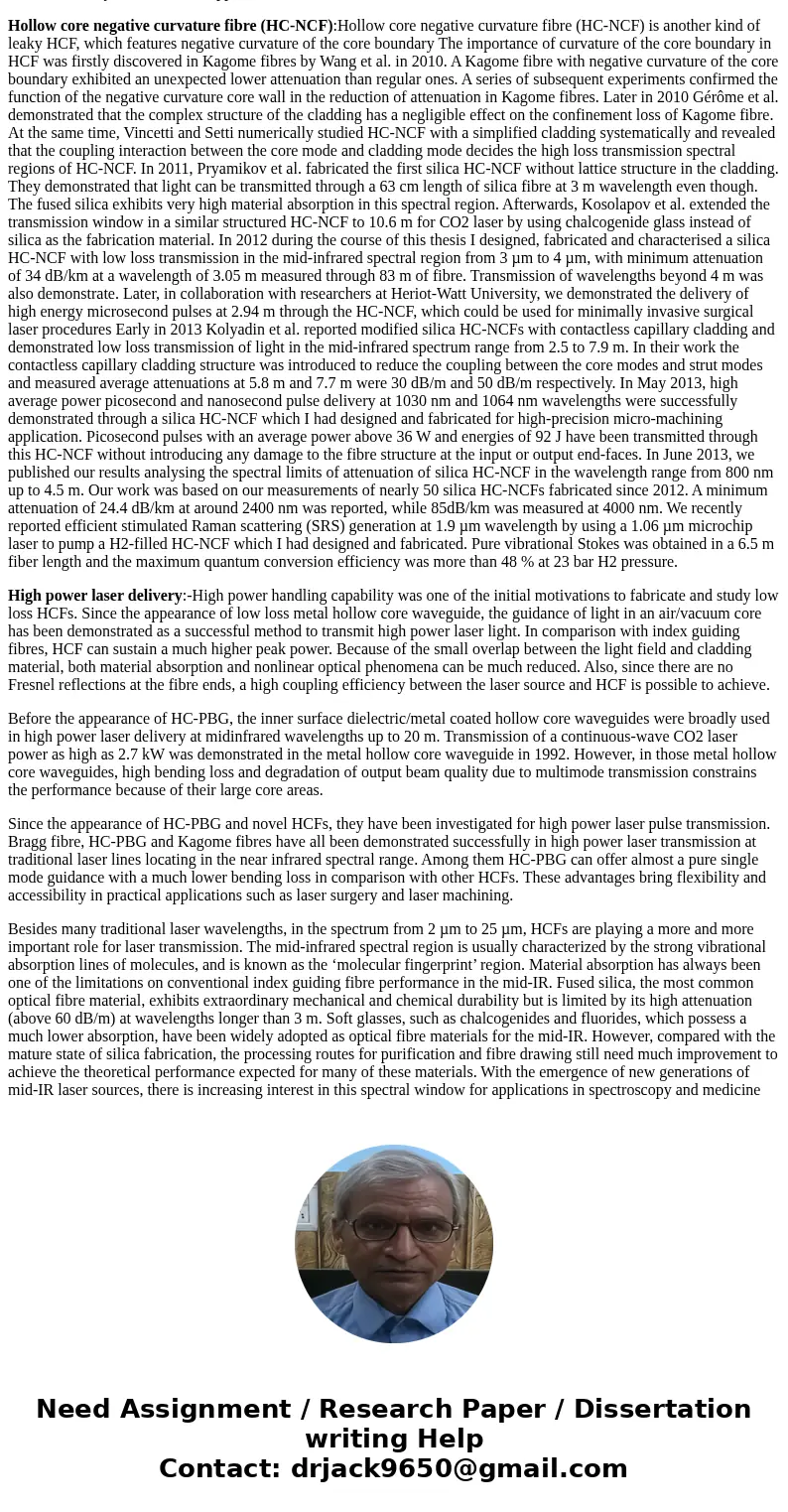Compare and Contrast hollow core fibers for high power deliv
Solution
NC-HCF:-NEGATIVE curvature hollow core optical fiber (NC-HCF) is a novel hollow core optical fiber (HCF) which has emerged over the last few years. NC-HCF is characterized by the inverted curvature of its core wall, and usually exhibits multiple spectral transmission bands of low attenuation. The simple structure of the fiber cladding allows flexible tailoring of NC-HCFs design and dimension for specific wavelengths and applications. Since their first appearance NC-HCFs have been applied in high power/ultrafast laser delivery and several other applications. This paper comprises eight sections:It consists of a brief history of NC-HCF, while the optics of NC-HCF will be discussed. From the guidance properties of NC-HCFs are collated and summarized including mode attenuation, bending loss, dispersion and nonlinearity. reviews some applications of NC-HCFs and contains conclusions.
Hollow core negative curvature fibre (HC-NCF):Hollow core negative curvature fibre (HC-NCF) is another kind of leaky HCF, which features negative curvature of the core boundary The importance of curvature of the core boundary in HCF was firstly discovered in Kagome fibres by Wang et al. in 2010. A Kagome fibre with negative curvature of the core boundary exhibited an unexpected lower attenuation than regular ones. A series of subsequent experiments confirmed the function of the negative curvature core wall in the reduction of attenuation in Kagome fibres. Later in 2010 Gérôme et al. demonstrated that the complex structure of the cladding has a negligible effect on the confinement loss of Kagome fibre. At the same time, Vincetti and Setti numerically studied HC-NCF with a simplified cladding systematically and revealed that the coupling interaction between the core mode and cladding mode decides the high loss transmission spectral regions of HC-NCF. In 2011, Pryamikov et al. fabricated the first silica HC-NCF without lattice structure in the cladding. They demonstrated that light can be transmitted through a 63 cm length of silica fibre at 3 m wavelength even though. The fused silica exhibits very high material absorption in this spectral region. Afterwards, Kosolapov et al. extended the transmission window in a similar structured HC-NCF to 10.6 m for CO2 laser by using chalcogenide glass instead of silica as the fabrication material. In 2012 during the course of this thesis I designed, fabricated and characterised a silica HC-NCF with low loss transmission in the mid-infrared spectral region from 3 µm to 4 µm, with minimum attenuation of 34 dB/km at a wavelength of 3.05 m measured through 83 m of fibre. Transmission of wavelengths beyond 4 m was also demonstrate. Later, in collaboration with researchers at Heriot-Watt University, we demonstrated the delivery of high energy microsecond pulses at 2.94 m through the HC-NCF, which could be used for minimally invasive surgical laser procedures Early in 2013 Kolyadin et al. reported modified silica HC-NCFs with contactless capillary cladding and demonstrated low loss transmission of light in the mid-infrared spectrum range from 2.5 to 7.9 m. In their work the contactless capillary cladding structure was introduced to reduce the coupling between the core modes and strut modes and measured average attenuations at 5.8 m and 7.7 m were 30 dB/m and 50 dB/m respectively. In May 2013, high average power picosecond and nanosecond pulse delivery at 1030 nm and 1064 nm wavelengths were successfully demonstrated through a silica HC-NCF which I had designed and fabricated for high-precision micro-machining application. Picosecond pulses with an average power above 36 W and energies of 92 J have been transmitted through this HC-NCF without introducing any damage to the fibre structure at the input or output end-faces. In June 2013, we published our results analysing the spectral limits of attenuation of silica HC-NCF in the wavelength range from 800 nm up to 4.5 m. Our work was based on our measurements of nearly 50 silica HC-NCFs fabricated since 2012. A minimum attenuation of 24.4 dB/km at around 2400 nm was reported, while 85dB/km was measured at 4000 nm. We recently reported efficient stimulated Raman scattering (SRS) generation at 1.9 µm wavelength by using a 1.06 µm microchip laser to pump a H2-filled HC-NCF which I had designed and fabricated. Pure vibrational Stokes was obtained in a 6.5 m fiber length and the maximum quantum conversion efficiency was more than 48 % at 23 bar H2 pressure.
High power laser delivery:-High power handling capability was one of the initial motivations to fabricate and study low loss HCFs. Since the appearance of low loss metal hollow core waveguide, the guidance of light in an air/vacuum core has been demonstrated as a successful method to transmit high power laser light. In comparison with index guiding fibres, HCF can sustain a much higher peak power. Because of the small overlap between the light field and cladding material, both material absorption and nonlinear optical phenomena can be much reduced. Also, since there are no Fresnel reflections at the fibre ends, a high coupling efficiency between the laser source and HCF is possible to achieve.
Before the appearance of HC-PBG, the inner surface dielectric/metal coated hollow core waveguides were broadly used in high power laser delivery at midinfrared wavelengths up to 20 m. Transmission of a continuous-wave CO2 laser power as high as 2.7 kW was demonstrated in the metal hollow core waveguide in 1992. However, in those metal hollow core waveguides, high bending loss and degradation of output beam quality due to multimode transmission constrains the performance because of their large core areas.
Since the appearance of HC-PBG and novel HCFs, they have been investigated for high power laser pulse transmission. Bragg fibre, HC-PBG and Kagome fibres have all been demonstrated successfully in high power laser transmission at traditional laser lines locating in the near infrared spectral range. Among them HC-PBG can offer almost a pure single mode guidance with a much lower bending loss in comparison with other HCFs. These advantages bring flexibility and accessibility in practical applications such as laser surgery and laser machining.
Besides many traditional laser wavelengths, in the spectrum from 2 µm to 25 µm, HCFs are playing a more and more important role for laser transmission. The mid-infrared spectral region is usually characterized by the strong vibrational absorption lines of molecules, and is known as the ‘molecular fingerprint’ region. Material absorption has always been one of the limitations on conventional index guiding fibre performance in the mid-IR. Fused silica, the most common optical fibre material, exhibits extraordinary mechanical and chemical durability but is limited by its high attenuation (above 60 dB/m) at wavelengths longer than 3 m. Soft glasses, such as chalcogenides and fluorides, which possess a much lower absorption, have been widely adopted as optical fibre materials for the mid-IR. However, compared with the mature state of silica fabrication, the processing routes for purification and fibre drawing still need much improvement to achieve the theoretical performance expected for many of these materials. With the emergence of new generations of mid-IR laser sources, there is increasing interest in this spectral window for applications in spectroscopy and medicine


 Homework Sourse
Homework Sourse